
Iranian calligraphers Majid Dastani, Ali Irani and Ali Ehsanipour received the first to third prizes respectively in the calligraphy style of thuluth.
In naskh style, Elham Mir-Talaei, Majid Saeed-Kafi and Ozra Abdollahpour were awarded the first, second and third prizes respectively.
Fardin Valizadeh, Hafez Ranjbar and Shamseddin Moradi won the first, second and third prizes respectively in nastaliq style of calligraphy.
A total of 215 calligraphers from 25 provinces showcased their works in Qazvin known as the capital of Persian calligraphy. Their works went on display at the large caravanserai that dates back to the Qajar Era (1786-1925).
The biennial included three categories. The first category was nastaliq, traditionally the predominant style in Persian calligraphy, which is a cursive script with long horizontal strokes and short verticals.
The second category is broken nastaliq, a development of nastaliq with spontaneous and uninhabited strokes.
Scripts of naskh and thuluth are included in the third category. Naskh is a small script with thin lines and round letter shapes, which is the preferred style for typesetting and printing. Thuluth is often used for titles or epigraphs rather than lengthy texts.
In the nastaliq category, 129 calligraphers participated, 57 artists presented their works in broken nastaliq, while in the styles of naskh and thuluth, works by 29 calligraphists went on view.
With 36 entries, Tehran Province had the largest contribution to the biennial. Next was the host province, Qazvin, with 33 works. Qom and Khorasan Razavi were third.
Source: Iran Daily
9376**1397
Follow us on Twitter @IrnaEnglish
 solhkhabar | Peace International News Agency Peace International News Agency , Peace News , International Agency News of Peace
solhkhabar | Peace International News Agency Peace International News Agency , Peace News , International Agency News of Peace